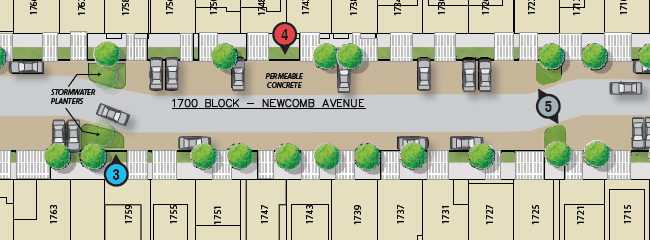
Newcomb Avenue Model Block Streetscape Improvement Project
Project status: completed
In 2009, Architecture for Humanity, a nonprofit network of design professionals, in coordination with the City, designed a conceptual traffic-calming, community building, and street-greening project for the 1700 block of Newcomb Avenue in San Francisco's Bayview district.
The Department of Public Works made major roadway renovations on Newcomb Avenue between Newhall and Phelps Street. The improvements included sewer-main replacement, roadway paving, sidewalk replacement, installation of new ADA curb-ramps, landscaping, green stormwater infrastructure, and traffic routing. This project installed special brick permeable pavers that enhance the esthetics of the block and infiltrate stormwater runoff.
The Newcomb Model Block project was funded by a 2010 grant from the Environmental Protection Agency's San Francisco Bay Water Quality Improvement Fund and with contributions from the San Francisco Redevelopment Agency and the San Francisco Public Utilities Commission and completed in partnership with the San Francisco Estuary Partnership.
Location
Newcomb Avenue between Newhall Street and Phelps Street.
Click image for larger view.
Goals
The project aimed to:
- Demonstrate the feasibility of green streets to provide multiple benefits and encourage a broad acceptance of Green Stormwater Infrastructure concepts
- Compare treated and untreated stormwater flows and volume; the maintenance costs of a green street; changes in traffic speed; and changes in value of adjacent properties
- Reduce stormwater flows and volume
Project Results
The City and County of San Francisco monitored the project to quantify reductions in stormwater runoff attributed to green infrastructure improvements and to develop a template for future projects.
Stormwater Management: This was one of San Francisco's first low-impact design demonstration projects. Since the project was conceived in 2009, we are seeing more and more greening and stormwater management included in streetscape projects, such as Cesar Chavez Street. More information about greening, stormwater management and other strategies to improve our streets can be found here.
With support from the San Francisco Public Utilities Commission and the San Francisco Estuary Institute, we monitored stormwater runoff on Newcomb to quantify the impact of the improvements on water quality. Preliminary monitoring results indicate that total flow reduction is around 55% compared to a calibrated simulation of pre-construction conditions, with volume decreasing from approximately 94% of the total rainfall down to around 40%. Peak discharges in each storm event are reduced between 20 and 100%, depending on storm size, intensity and saturation condition of the catchment.
Traffic Speed: The speed reduction is significant. Our goal was to get the vehicle 85th percentile within 5 mph of the speed limit. The volume reduction is also significant and a little hard to explain. Our thought is that Newcomb was used as a minor cut through street but was not critical for most users. The drop in volume could be attributed to the long construction period and that motorist then developed new patterns.
| Newcomb Avenue between Phelps and Newhall Streets | Before Construction 6/12/2007 | After Construction 12/11/2013 |
| ADT (bi-directional) | 1431 | 609 |
| WB 85th Percentile | 31.2 | 28.2 |
| EB 85th Percentile | 29.1 | 26.4 |
Property Value: Given macro-economic forces, an objective evaluation of the effects of the street improvements on surrounding property values is difficult to ascertain.

